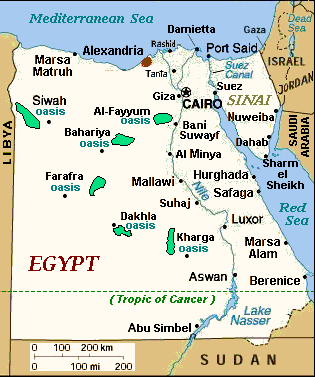- Famine Stela
Location map | 100x100
Alternative
caption = Location of Famine Stele in Egypt
width=250
label=Famine Stele | label-size=80
background = #CCCCCC | position=right
lat_deg = 24 | lat_min = 3
lat_deg = 28
lon_deg = 32 | lon_min = 52
lon_deg = 71
lat = 38
mark=Red_pog.svg
marksize=8
float=right The Famine Stele is an inscription located onSehel Island in theNile nearAswan inEgypt , which speaks of a seven year period of drought and famine during the reign of the 3rd dynastypharaoh Djoser . The top part of thestele depicts three Egyptian deities:Khnum ,Satis andAnuket . In front of them,Djoser faces them, carrying offerings in his outstretched hands.The inscription
The text [ [http://www.reshafim.org.il/ad/egypt/famine_stele.htm The Famine Stela] . Retrieved
June 1 ,2005 . "After a German translation by Günther Roeder, Jena, 1923"] describes how the king is upset and worried, as the land of Egypt has been in the grip of a drought for seven years, during which time theNile has not flooded the nearby lands. Djoser asks the priests of his ministerImhotep for help. They decide to investigate in the archives of the temple ofThoth inHermopolis . A priest informs the king that the Nile flooding is controlled by Khnum atElephantine Island , in the south of the valley: the god Khnum is angry, and for this reason, he does not allow the waters of the Nile to flow properly. Djoser orders offerings to be carried to the south, to try and placate the god. In the following night, the king has a dream in which he sees Khnum, who promises an end to the famine. The king issues a decree in which grants the temple of Khnum at Elephantine the region between Aswan and Takompso with all its wealth, as well as a share of all the imports fromNubia . [M. Lichtheim, "op.cit.", p.95]Dating of the inscription
The Famine Stele was probably carved during Ptolemaic times (likely during the reign of
Ptolemy V Epiphanes ), but claims to record events of the time ofDjoser in the 3rd Dynasty. Some Egyptologists think that it recalls a genuine decree issued by Djoser, others consider it to be fiction. [M. Lichtheim, "op.cit.", p.95]Notes
References
*cite book | author= Lichtheim, Miriam | authorlink= Miriam Lichtheim| year= 1980 | title= Ancient Egyptian Literature Vol 3 | publisher= The University of California Press 1980 | location= | pages=
*cite book | author= Barguet, Paul | year= 1943 | title= La stèle de la famine à Séhel | publisher= Imprimerie de l’Institut français d’archéologie orientale du Caire | location= Cairo | pages=
*cite book | author= Yan Haiying | editor= Christopher John Eyre (eds.) | year= 1998 | title= Proceedings of the Seventh International Congress of Egyptologists; Cambridge, 3–9 September 1995 | publisher= Uitgeverij Peeters | location= Leuven | pages= 515–521 | chapter=The Famine Stela: A Source-Critical Approach and Historical-Comparative Perspective
*cite book | author= Vandier, Jacques Victor Edmond Raymond | year= 1936 | title= La famine dans l’Égypte ancienne | publisher= Imprimerie de l’Institut français d’archéologie orientale du Caire | location= Cairo | pages=
Wikimedia Foundation. 2010.
